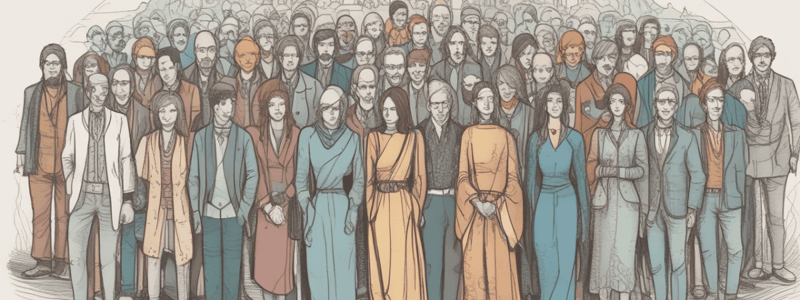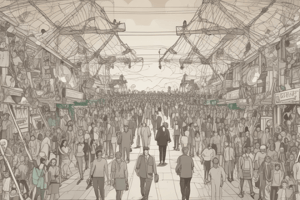Podcast
Questions and Answers
What is a key characteristic of a social group?
What is a key characteristic of a social group?
- A shared income level
- Interaction and common interests (correct)
- A specific geographic location
- A large number of individuals
What is an example of a category rather than a group?
What is an example of a category rather than a group?
- A church congregation
- A sports team
- A family
- Women (correct)
According to Charles Horton Cooley, what is a primary group?
According to Charles Horton Cooley, what is a primary group?
- A temporary gathering of strangers
- A large, formal organization
- A small, close-knit group with enduring bonds (correct)
- A group with a specific social identity
What can cause a crowd to transform into a group quickly?
What can cause a crowd to transform into a group quickly?
What is true about members of a primary group?
What is true about members of a primary group?
What is a characteristic of a crowd?
What is a characteristic of a crowd?
What is NOT a type of group?
What is NOT a type of group?
What are two examples of organizations in Pakistan that promote social interaction and cooperation?
What are two examples of organizations in Pakistan that promote social interaction and cooperation?
What type of groups have a set structure, objectives, and regulations?
What type of groups have a set structure, objectives, and regulations?
What serves as a point of comparison when evaluating our own beliefs and actions?
What serves as a point of comparison when evaluating our own beliefs and actions?
What is the term for the process of conforming to groups we do not belong to in order to gain acceptance from others?
What is the term for the process of conforming to groups we do not belong to in order to gain acceptance from others?
What is the term for a social group that a person feels competition with or hostility from?
What is the term for a social group that a person feels competition with or hostility from?
According to Simmel, what is the smallest social group consisting of two members?
According to Simmel, what is the smallest social group consisting of two members?
What is the result of conflict between in-groups and out-groups?
What is the result of conflict between in-groups and out-groups?
What is the primary reason why people value relationships in primary groups?
What is the primary reason why people value relationships in primary groups?
What term do sociologists use to describe the behavior of people in secondary groups?
What term do sociologists use to describe the behavior of people in secondary groups?
What is a characteristic of secondary groups?
What is a characteristic of secondary groups?
What is the primary function of primary groups according to Cooley?
What is the primary function of primary groups according to Cooley?
What is a result of our identity being shaped by primary groups?
What is a result of our identity being shaped by primary groups?
Why are secondary groups important in modern society?
Why are secondary groups important in modern society?
What is a benefit of secondary groups?
What is a benefit of secondary groups?
Why are dyads inherently unstable?
Why are dyads inherently unstable?
What is the primary advantage of a triad over a dyad?
What is the primary advantage of a triad over a dyad?
Why may a married couple seek out a third party, such as a counselor?
Why may a married couple seek out a third party, such as a counselor?
What is a potential drawback of a triad?
What is a potential drawback of a triad?
What is the significance of the proverb 'Two's company, three's a crowd'?
What is the significance of the proverb 'Two's company, three's a crowd'?
What is a characteristic of larger groups?
What is a characteristic of larger groups?
What is the relationship between group size and personal engagement?
What is the relationship between group size and personal engagement?
What is the role of formal rules and regulations in larger groups?
What is the role of formal rules and regulations in larger groups?
Why are married dyads sustained in society?
Why are married dyads sustained in society?
Flashcards are hidden until you start studying
Study Notes
Social Groups
- A social group consists of two or more individuals who interact and share common interests, maintaining their uniqueness while thinking of themselves as a unique "we".
Nature of Groups: Primary vs Secondary
- Primary Group: A small, close-knit group where people connect informally, forming enduring bonds, and valuing relationships for themselves, not just for what they can achieve.
- Examples: couples, families, close friends, and neighbors.
- Secondary Group: A formal, impersonal setting where individuals work together to achieve a single goal, relating to each other in terms of specific responsibilities.
- Examples: teachers and students, coworkers, and club members.
Functions of Groups
- Primary groups provide a sense of belonging, emotional support, and shape our identity.
- Secondary groups are crucial for modern civilization, facilitating education, earning a living, spending leisure time, and encouraging social interaction and cooperation.
Types of Groups
- In-group: A group we feel loyal to and belong to.
- Out-group: A group we feel opposed to or in rivalry with.
- Formal group: Has a set structure, objectives, and regulations.
- Informal group: Formed based on common interests or social links.
- Virtual group: Communicates mostly online, such as social media networks or online communities.
Reference Group
- A social group that serves as a point of comparison, influencing our beliefs and actions.
- Can be primary or secondary, and we often use them to evaluate ourselves.
In-group and Out-group
- In-group: A social group we respect and feel devoted to.
- Out-group: A social group we feel competition with or hostility from.
- Conflict between in-groups and out-groups accentuates the boundaries between groups and helps people define their social identities.
Group Size: Dyad and Triad
- Dyad: A social group with two members, characterized by intense social interaction, but unstable and dependent on both participants.
- Triad: A social group with three members, more stable than a dyad, with one member potentially serving as a mediator in conflicts.
Key Concepts
- Anticipatory socialisation: Conforming to groups we do not belong to in order to gain acceptance from others.
- Cooley's "primary groups" concept: Small, close-knit groups that are fundamental in forming the social nature and ideas of the individual.
Studying That Suits You
Use AI to generate personalized quizzes and flashcards to suit your learning preferences.




